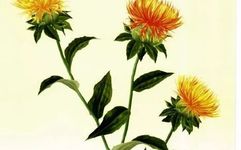Herb Name: Safflower (Honghua)
Alias: Red Blue Flower, Thistle Safflower, Grass SafflowerHarvesting and Processing: Flowers bloom in late May, with peak flowering from late May to mid to late June, harvested in batches. Choose sunny days, and harvest between 6-8 AM when the tubular flowers are fully opened and golden yellow; if harvested too late, the tubular flowers wilt and turn red-black, making harvesting difficult, resulting in poor quality and low yield. After harvesting, dry in the shade or use low-temperature drying at 40-60°C.Medicinal Part: FlowerOrigin: Northeast, North China, Northwest, and provinces such as Shandong, Zhejiang, Guizhou, Sichuan, Tibet, etc.Family: AsteraceaeOriginal Plant: SafflowerPlant Characteristics: Annual herb

Height: 50-100 cm. Stem erect, branched at the upper part, white or light white, smooth and hairless.
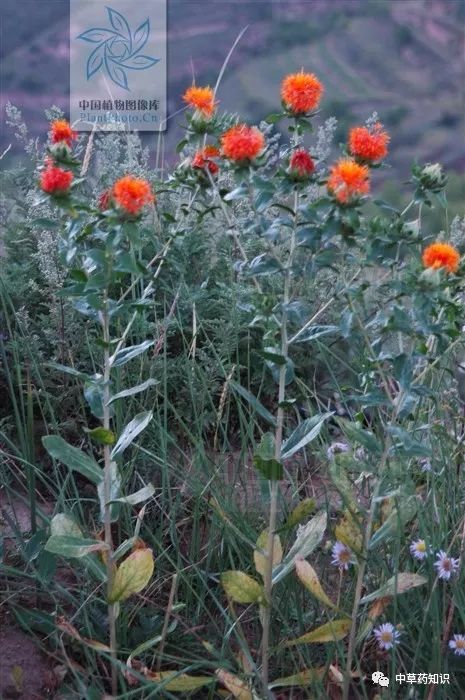
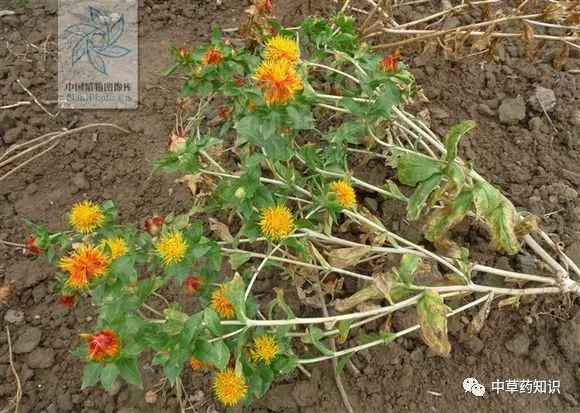
Leaves alternate; without petioles; middle to lower stem leaves are lanceolate, ovate-lanceolate, or oblong-ovate, 7-15 cm long, 2.5-6 cm wide, with large serrations, heavy serrations, small serrations, or entire edges, occasionally deeply lobed, with spiny tips, spines 1-1.5 mm long, upper leaves gradually smaller, lanceolate, serrated edges, with longer spiny tips, up to 3 mm; all leaves are hard, leathery, hairless on both sides, without glandular dots, and glossy.
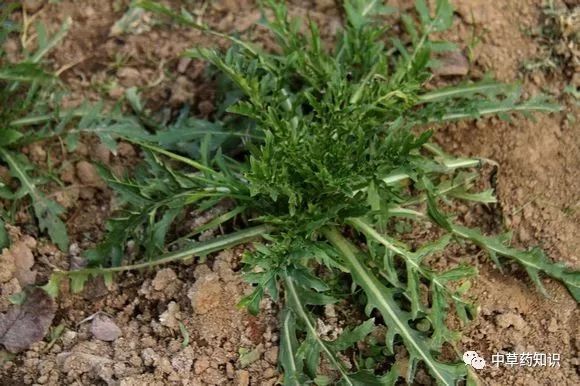
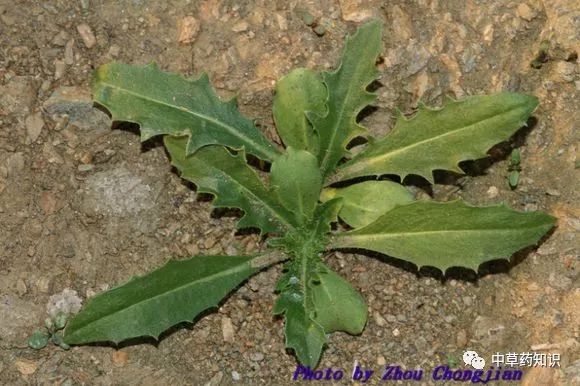
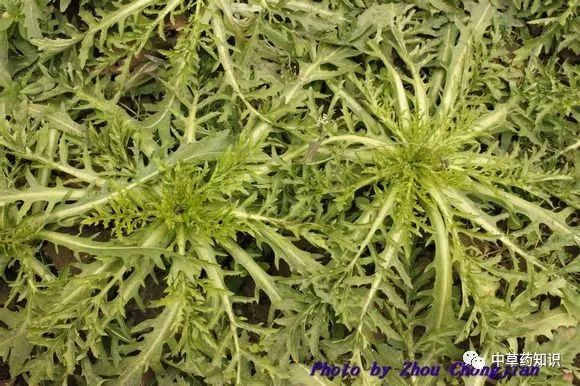
Capitula numerous, arranged in a corymbose inflorescence at the top of the stem branches, surrounded by bracts; bracteoles oval or ovate-lanceolate, with spiny tips 2.5-3 cm long, edges may or may not have spines; involucre shape, diameter 2.5 cm; involucre has 4 layers, outer layer is lyre-shaped, with constrictions in the middle or lower part, above the constriction the leaf texture is green, edges without spines or with comb-like spines, below the constriction yellow-white; middle inner layer is hard and membranous, inversely lanceolate to long inversely lanceolate, up to 2.2 cm long, gradually pointed at the tip; all bracts hairless, without glandular dots; florets are red, orange-red, all bisexual, corolla length 2.8 cm, tube length 2 cm, corolla lobes nearly reach the base of the limb.
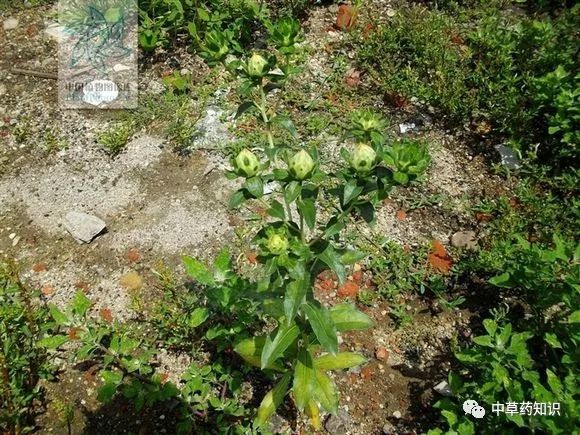
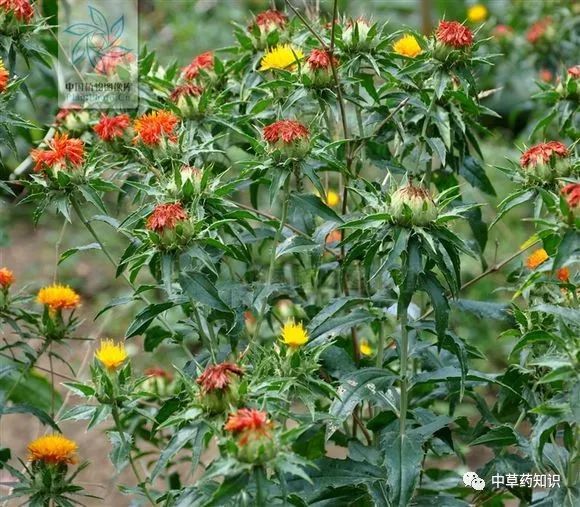
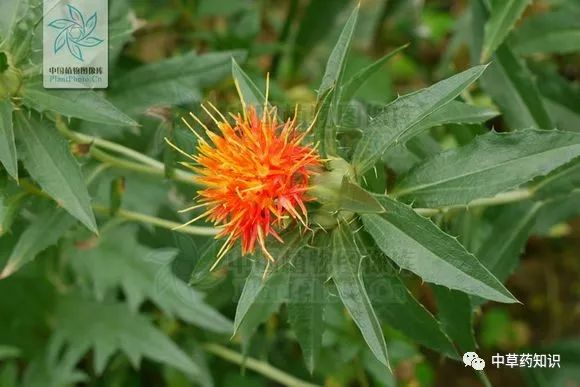
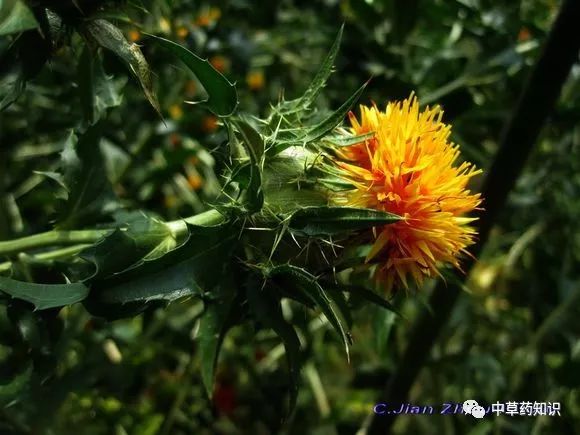
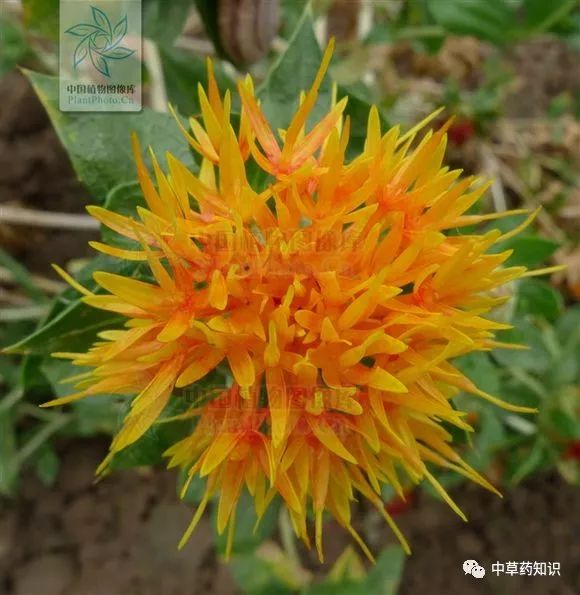
Achenes inverted ovate, 5.5 mm long, 5 mm wide, milky white, with 4 ridges, without pappus. Flowering and fruiting period: May to August.
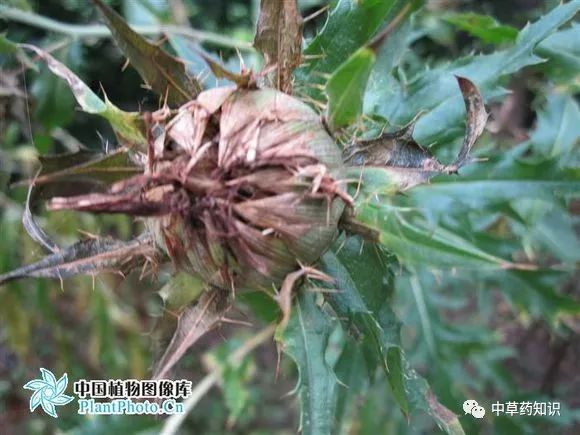
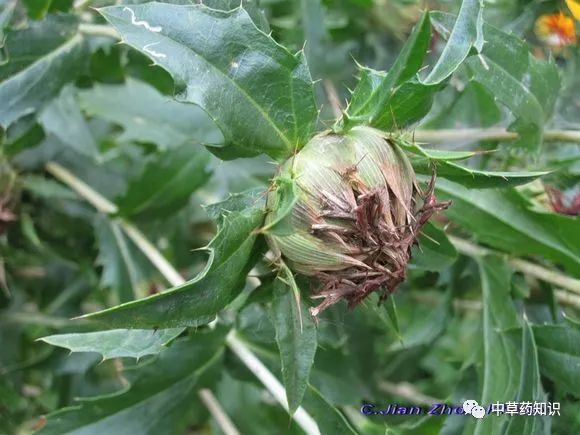
Safflower medicinal characteristics: “Tubular flowers without ovaries, 1-2 cm long. Surface red-yellow or red. Corolla tube long and slender, with 5 lobes at the tip, lobes narrow and 5-8 mm long. Stamens 5, anthers fused into a tubular shape, yellow-white. Style long cylindrical, slightly bifurcated at the tip. Texture soft. Aroma faintly fragrant, taste slightly bitter.
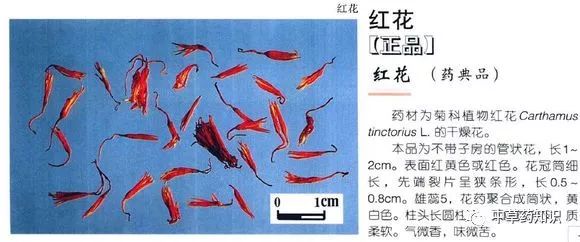
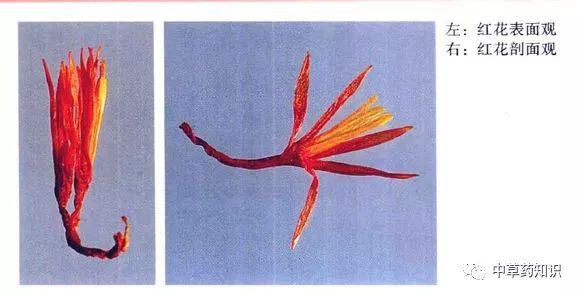
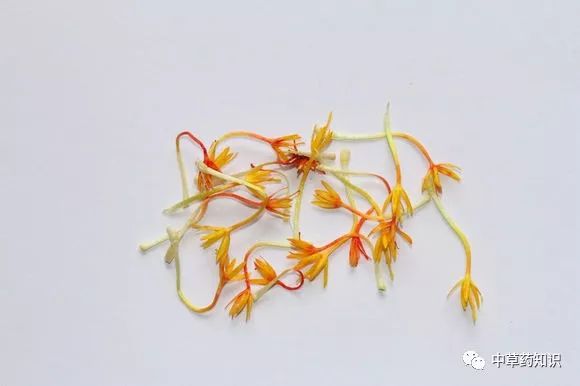

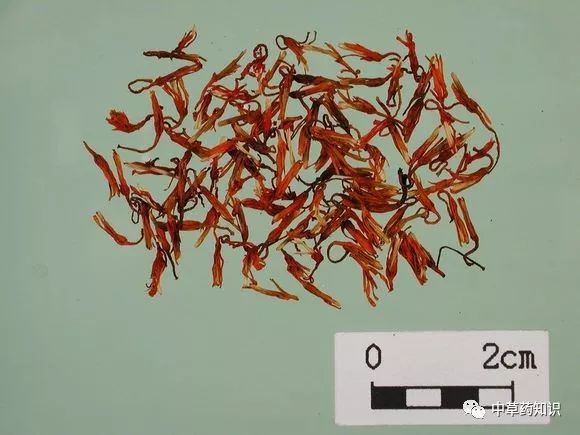
Safflower medicinal properties: “Taste pungent, enters the Liver meridian (Gan jing) and the Heart meridian (Xin jing). Specializes in promoting blood circulation and alleviating pain, particularly effective for abdominal pain due to blood stasis. According to the “Jinkui Yao Lue”, Safflower Wine (1 liang of safflower, 1 sheng of wine, decoct to reduce by half, take in divided doses) treats various wind conditions in women and stabbing pain in the abdomen due to blood stasis. The Liver stores blood; when the Wood element is stagnant, it causes the Wind to move, leading to dryness of Liver blood, which in turn causes pain. Safflower promotes blood circulation and breaks up stasis, while yellow wine warms the meridians and disperses stagnation.Safflower invigorates blood circulation, moistens dryness, alleviates pain, and is particularly effective in clearing Wind and promoting the flow of Qi. Its indications include: unblocking meridians, reducing swelling, expelling retained placenta, opening the throat, reviving from fainting, and treating ear disorders.【Caution】 Not suitable for pregnant women.【Additional Formulas】1. For women with obstructed menstruation, such as blood stasis: Safflower (finely chopped), Su Mu (sandalwood, pounded), and Dang Gui (Angelica) in equal parts. Finely chop, use 1 liang, with 1.5 sheng of water, first decoct the flowers and wood; then add 1 cup of wine and Dang Gui, decoct again, and take warm before meals. (From “Zhu’s Collection of Verified Medical Formulas”)2. For heat illness leading to fetal death: Safflower wine decoction, drink 2-3 cups. (From “Supplement to Good Formulas for Women”)3. For retained placenta: Safflower wine decoction, drink 2-3 cups. (From “Collection of Verified Formulas for Lactation”)4. For women with various wind conditions and stabbing pain in the abdomen: 1 liang of safflower. Use 1 large sheng of wine, decoct to reduce by half, take half at once, and if pain persists, take again. (From “Jinkui Yao Lue Safflower Wine”)5. For all types of swelling: Safflower, cooked, mashed, and taken as juice. (From “Secret Formulas from the Outer Chamber”)6. For throat obstruction and difficulty in swallowing: Safflower juice, 1 small sheng, take as needed. If no moist flowers are available in winter, soak and dry them to extract juice as before. (From “Collection of Verified Formulas from the Sea”)7. For ear discharge and foul-smelling pus: 1 fen of safflower, 1 liang of white alum (burnt to ash). Grind the above ingredients into a fine powder, use a small amount in the ear. (From “Shenghui Fang”)8. For bruises and injuries from walls: 1 fen of Chuan Ma, 2 fen of Mu Xiang, 3 fen of safflower, 4 fen of licorice. All used raw, ground into powder, taken with yellow wine. (From “Emergency Formulas”)9. For bedsores: Safflower in appropriate amount, soak in wine and apply externally. (From “Yunnan Chinese Herbal Medicine”)【Nature and Flavor】 Pungent, warm.【Meridian Affinity】 Enters the Heart and Liver meridians.【Functions and Indications】 Invigorates blood, unblocks menstruation, disperses stasis, and alleviates pain. Used for amenorrhea, dysmenorrhea, retained lochia, abdominal masses, traumatic injuries, and painful swellings.【Dosage】 3-9 g.【Caution】 Use with caution in pregnant women.【Storage】 Store in a cool, dry place, protect from moisture and pests.【Various Discussions】 1. “Tang Bencao”: Treats locked jaw, blood clots, and various postpartum ailments.2. “Kaibao Bencao”: Main treatment for postpartum blood circulation issues, abdominal pain due to retained blood, and fetal death in utero, decocted with wine. Also treats toxic blood loss.3. “Bencao Mengquan”: For throat obstruction and difficulty swallowing, juice is pounded and swallowed.4. “Gangmu”: Invigorates blood, moistens dryness, alleviates pain, disperses swelling, and unblocks menstruation.5. “Bencao Zheng”: Treats difficult eruptions and blood heat that is hard to expel, disperses rashes and blood stagnation.6. “Bencao Zhaixin”: Promotes urination and reduces swelling, stabilizes pregnancy, and prevents fetal death.7. “Bencao Yanyi Buyi”: Safflower breaks up retained blood and nourishes blood. Excessive use can break blood, while minimal use can nourish blood.8. “Bencao Jing Shu”: Safflower is a key herb for invigorating blood. It treats postpartum fainting and locked jaw due to retained blood not being expelled, which causes upward counterflow to the heart, leading to fainting and locked jaw. Abdominal cramping is due to retained blood, and fetal death in utero cannot be expelled without invigorating blood. Stasis leads to blood activation, thus alleviating cramping and expelling dead fetus. Safflower is primarily a blood-invigorating herb; it resolves fainting and stagnation, stopping excessive bleeding. Overuse can lead to excessive bleeding and death.9. “Bencao Huiyan”: Safflower breaks blood, moves blood, harmonizes blood, and regulates blood. It is the main herb for various ailments caused by blood issues in pregnancy, such as blood vexation, fainting, and inability to speak; or retained lochia causing heart pain and abdominal cramping; or difficulty in childbirth; or retained placenta, fetal death in utero, all of which are conditions that safflower can treat. If menstruation is obstructed and cold-heat alternates, or if there is abdominal pain with purple-black discharge, or if there are traumatic injuries with Qi and blood stagnation, or if there are painful and itchy sores, all of which are conditions of Qi and blood disharmony that safflower can regulate.10. “Yaopin Huayi”: Safflower is effective in unblocking meridians, being a Qi herb in the blood, capable of both purging and supplementing, each with its own unique significance. If used in excess (3-4 qian), it can be overly pungent and warm, causing blood to disperse. Combined with Su Mu to move stasis, and with cinnamon to unblock menstruation, along with Dang Gui and Shao Yao to treat widespread or abdominal blood stasis pain, this is how it invigorates blood. If used minimally (7-8 fen), it can soothe Liver Qi and assist in nourishing blood, thus harmonizing and nourishing blood; if used in small amounts (2-3 fen), it enters the heart to harmonize heart blood, resolving heart fire and harmonizing blood. The significance of dosage is profound.

